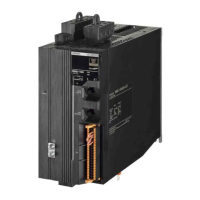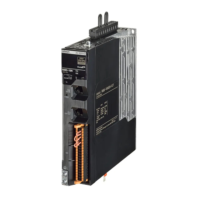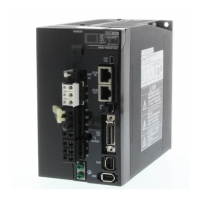Do you have a question about the Omron R88D-1SN02H-ECT and is the answer not in the manual?
| Product Type | Servo Drive |
|---|---|
| Model | R88D-1SN02H-ECT |
| Series | R88D |
| Maximum Output Current | 3.0 A |
| Communication Interface | EtherCAT |
| Ambient Operating Temperature | 0 to 55 °C |
| Supply Voltage | 200-240V AC |
| Control Method | Position control, speed control, torque control |
| Protection Functions | Overcurrent, Overvoltage, Overload, Overheat, Encoder Error |
| Shock Resistance | 98 m/s² |
| Ambient Operating Humidity | 20 to 90% (non-condensing) |
Explains installation conditions and wiring methods, including EMC directives.
Explains the function and examples of operation and connection.
Explains details of each servo parameter, including set values, settings, and display.
Provides operational procedures and explains how to operate in each mode.
Explains functions, setting methods, and items to note regarding adjustments.
Explains items to check when problems occur and troubleshooting by error displays or operation state.
Explains that qualified engineers must develop safety systems and install safety products properly.
Qualified engineers must develop safety-related systems and install safety products correctly.
Carefully read specifications and precautions to learn appropriate usage procedures.
Wire cables correctly and securely to prevent runaway motor, injury, or failure.
Observe mounting direction and specified clearance for proper installation to prevent fire or failure.
Explains the procedures to operate a system that incorporates 1S-series Servo Drives.
Outlines the overall procedure for building a system and using safety functions, including standard and safety control.
Explains the procedure details for using the Servo Drive safety function, referencing other manuals for standard and safety control.
When you wire the main circuit, use proper wire sizes, grounding systems, and noise resistance.
The specifications of the safety I/O are shown below.
The overload protection function (electronic thermal) is built into the Servo Drive to protect the Servo Drive and Servomotor from overloading.
Explains the conditions for installing Servo Drives, Servomotors, Decelerators, and noise filters.
Explains the space conditions around Servo Drives with its capacity 3 kW or less.
This section gives the examples of connection with peripheral equipment and wiring such as connection of the main circuit and Servomotor.
Shows the peripheral equipment connection examples for R88D-1SN01L-ECT/-1SN02L-ECT/-1SN04L-ECT/-1SN01H-ECT/-1SN02H-ECT/-1SN04H-ECT/-1SN08H-ECT (Single-phase Input).
Describes each procedure for wiring a terminal block and for mounting power cables or shield clamp to a Servo Drive.
1S-series Servo Drives conform to the EMC Directives (EN 61800-3) under the wiring conditions described in this section.
Shows the peripheral equipment connection examples for R88D-1SN01L-ECT/-1SN02L-ECT/-1SN04L-ECT/-1SN01H-ECT/-1SN02H-ECT/-1SN04H-ECT/-1SN08H-ECT.
Describes the criteria for selecting connection components that are required to improve noise immunity.
Explains the applicable Servomotor load inertia value to prevent Servo Drive circuits from damage.
Explains that the process data objects (PDOs) are used for real-time data transfer during cyclic communications.
Provides mapping for the application objects (real-time process data) between the object dictionary and PDOs.
Explains that when an error or warning occurs, an emergency message is sent to the master through SDO communications.
Explains configuring a ring topology on the EtherCAT system enables communications to continue even if an EtherCAT physical layer link is disconnected.
Describes how to check that the cable redundancy function operates correctly.
The block diagrams for TDF position control and ODF position control are given.
The block diagrams for TDF velocity control and ODF velocity control are given.
The block diagram for torque control is given.
In this mode, the controller gives the target position to the Servo Drive in cyclic synchronization.
In this mode, the controller gives the target velocity to the Servo Drive in cyclic synchronization.
In this mode, the controller gives the target torque to the Servo Drive in cyclic synchronization.
In this mode, the controller uses the path generation function to perform PTP positioning.
In this mode, the controller uses the path generation function to control the velocity.
In this mode, the Servo Drive has a path generation function and executes homing.
Describes the settings required to connect the Servo Drive with an OMRON controller.
Explains that if the Positive Drive Prohibition Input (POT) or Negative Drive Prohibition Input (NOT) is active, the motor will stop rotating.
Notifies that the present position exceeded the specified movement range and stops the Servomotor rotation.
Lets you set the output timing for the Brake Interlock Output (BKIR) signal.
Controls the position by using the value that is obtained by multiplication of the position command input.
Switches the torque limit according to the operation direction and depending on the Positive Torque Limit (PCL), Negative Torque Limit (NCL), and Positive/Negative Torque Limit Input Commands.
Shows the operations performed according to the setting of the Torque Limit - Switching Selection.
Performs auto acceleration and deceleration when step-type velocity commands are input.
Switches the position control gain, velocity control gain, and torque command filter.
Latches the actual position and time stamp at the rising edge of an external latch input signal or the encoder's phase-Z signal.
Explains that the dynamic brake can be used to stop the Servomotor in events such as drive prohibition input, Servo OFF, and occurrence of an error.
Used to cut off the motor current and stop the motor through the input signals from a safety controller.
Explains how to use the STO function via the safety input signals.
Explains the I/O signals available for the STO function and external device monitoring (EDM) output signal.
Shows the timing charts to show the operation timing to a safe state as well as the timing of return from safe state.
Shows how to connect the safety inputs and the EDM output to the safety controller.
Explains how to use the STO function via EtherCAT communications.
Explains the network connection and settings for the EtherCAT master and the Safety CPU Unit.
Shows the operation timing to a safe state and the timing of return from safe state.
Explains how to connect an NX-series Safety CPU Unit.
Sets the basic functions of Servo Drives.
Sets the position command and gives the command value.
Sets the position command filter.
Sets the velocity command and gives the command value.
Sets the velocity command filter.
Sets the torque command and gives the command value.
Sets the profile command.
Sets the velocity feed-forward in the one-degree-of-freedom control.
Sets the torque feed-forward in the one-degree-of-freedom control.
Sets the operation in the two-degree-of-freedom position control.
Sets the operation in the two-degree-of-freedom velocity control.
Explains the objects related to the control loop.
Gives the position command value which is calculated in the Servo Drive.
Sets the gain switching function in the position control.
Sets the gain switching function in the velocity control.
Sets the torque command and gives the command value.
Sets the torque compensation.
Reduces resonance frequency vibration by estimating the resonance frequency from the vibration component.
Sets the torque limit function.
These objects are used for the homing setting.
Sets the drive prohibition function.
Sets the software position limit function.
Sets the operation during stop.
Sets the Latch Function 1 (Touch Probe 1).
Sets the Latch Function 2 (Touch Probe 2).
Sets the Position Detection Function.
Sets the Speed Detection Function.
Sets the operation of the load characteristic estimation.
Gives the error code.
Gives the error code.
Sets the warning detection function.
Sets the object for monitoring. You can monitor any object by mapping the monitor data to a TxPDO.
Counts the number of EtherCAT communication errors and clears the error count value.
Monitors the safety function.
Explains the operational procedure and how to operate in each mode.
Explains the procedure to prepare the system for operation after installation and wiring.
Requires setup when turning ON the power supply for the first time for motors with an absolute encoder.
Confirms that the servo system operation is electrically correct after installation, wiring, and switch settings.
Describes how to perform a test run via USB communications from Sysmac Studio.
Adjusts the gain automatically while the Servomotor is operated based on commands from the Controller or operation conditions.
Explains how to execute the easy tuning using Sysmac Studio.
Uses simulation to adjust the gain and filter settings.
Adjusts multiple gain parameters at a time according to set values for machine rigidity.
Reduces vibration generated by a low-rigidity machine.
Estimates the load characteristics of the machine and sets values of inertia ratio, viscous friction, etc.
Reduces resonance frequency vibration by estimating the resonance frequency from the vibration component.
Reduces a specified frequency component.
Compensates friction torque to reduce the influence of mechanical frictions.
Improves the following performance for the target position and velocity.
Explains the preliminary checks required to determine the cause of a problem if one occurs.
Checks the voltage at the power supply input terminals.
Provides precautions to take when checking and verifying I/O after a problem occurred.
Explains the procedure to replace the Servomotor or Servo Drive.
Outputs a warning signal to enable checking a state such as an overload before an error occurs.
Lists general warnings and EtherCAT communications warnings.
If the Servo Drive detects an abnormality, it outputs an error (/ERR), turns OFF the power drive circuit, and displays the error number.
Identifies the cause of the error and takes appropriate measures.
Explains how to troubleshoot using the error displays.
Notifies users of errors related to EtherCAT communications, as well as their causes and remedies.
Explains how to troubleshoot using the operation state.
Lists and describes the error event codes that can be seen in Sysmac Studio.
Lists and describes the error event codes that can be seen in Sysmac Studio.
Describes errors.











